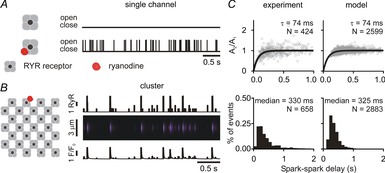Figure 4.

Mathematical modelling results
A, simulations of 4 s of activity of isolated RyR either without (top) or with (bottom) a single ryanodine molecule bound. Ryanodine was assumed to cause repetitive openings due to a dramatic decrease in mean closed time (28,175 s to 55 ms). Mean open time was 2 ms in either condition. B, simulations of a single ryanodine-bound RyR within a cluster of channels resulted in repetitive Ca2+ sparks, as seen in either the number of open channels (top), simulated line scan (middle) or simulated Ca2+ spark time course (bottom). We set a threshold of 5 open channels for an event to be defined as an identifiable spark (Williams et al. 2011). C, Ca2+ spark amplitude restitution and spark-to-spark delays as observed experimentally (left) and as simulated numerically (right).
